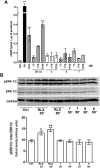Synthetic short-chain peptide analogues of H1 relaxin lack affinity for the RXFP1 receptor and relaxin-like bioactivity. Clues to a better understanding of relaxin agonist design
- PMID: 36034864
- PMCID: PMC9402926
- DOI: 10.3389/fphar.2022.942178
Synthetic short-chain peptide analogues of H1 relaxin lack affinity for the RXFP1 receptor and relaxin-like bioactivity. Clues to a better understanding of relaxin agonist design
Abstract
The peptide hormone relaxin (RLX), also available as clinical-grade recombinant protein (serelaxin), holds great promise as a cardiovascular and anti-fibrotic agent but is limited by the pharmacokinetic issues common to all peptide drugs. In this study, by a computational modelling chemistry approach, we have synthesized and tested a set of low molecular weight peptides based on the putative receptor-binding domain of the B chain of human H1 RLX isoform, with the objective to obtain RLX analogues with improved pharmacokinetic features. Some of them were stabilized to induce the appropriate 3-D conformation by intra-chain tri-azolic staples, which should theoretically enhance their resistance to digestive enzymes making them suited for oral administration. Despite these favourable premises, none of these H1 peptides, either linear or stapled, revealed a sufficient affinity to the specific RLX receptor RXFP1. Moreover, none of them was endowed with any RLX-like biological effects in RXFP1-expressing THP-1 human monocytic cells and mouse NIH-3T3-derived myofibroblasts in in vitro culture, in terms of significantly relevant cAMP elevation and ERK1/2 phosphorylation, which represent two major signal transduction events downstream RXFP1 activation. This was at variance with authentic serelaxin, which induced a clear-cut, significant activation of both these classical RLX signaling pathways. Albeit negative, the results of this study offer additional information about the structural requirements that new peptide therapeutics shall possess to effectively behave as RXFP1 agonists and RLX analogues.
Keywords: ERK1/2; RXFP1; RXFP1 agonists; cAMP; relaxin; relaxin analogues.
Copyright © 2022 D'Ercole, Nistri, Pacini, Carotenuto, Santoro, Papini, Bathgate, Bani and Rovero.
Conflict of interest statement
The authors declare that the research was conducted in the absence of any commercial or financial relationships that could be construed as a potential conflict of interest.
Figures



Similar articles
-
The anti-fibrotic actions of relaxin are mediated through AT2 R-associated protein phosphatases via RXFP1-AT2 R functional crosstalk in human cardiac myofibroblasts.FASEB J. 2020 Jun;34(6):8217-8233. doi: 10.1096/fj.201902506R. Epub 2020 Apr 16. FASEB J. 2020. PMID: 32297670
-
Characterization of a new potent and long-lasting single chain peptide agonist of RXFP1 in cells and in vivo translational models.Sci Rep. 2022 Nov 28;12(1):20435. doi: 10.1038/s41598-022-24716-2. Sci Rep. 2022. PMID: 36443381 Free PMC article.
-
In search of a small molecule agonist of the relaxin receptor RXFP1 for the treatment of liver fibrosis.Sci Rep. 2017 Sep 7;7(1):10806. doi: 10.1038/s41598-017-10521-9. Sci Rep. 2017. PMID: 28883402 Free PMC article.
-
Human Recombinant Relaxin (Serelaxin) as Anti-fibrotic Agent: Pharmacology, Limitations and Actual Perspectives.Curr Mol Med. 2022;22(3):196-208. doi: 10.2174/1566524021666210309113650. Curr Mol Med. 2022. PMID: 33687895 Review.
-
Relaxin in hepatic fibrosis: What is known and where to head?Biochimie. 2021 Aug;187:144-151. doi: 10.1016/j.biochi.2021.06.001. Epub 2021 Jun 5. Biochimie. 2021. PMID: 34102254 Review.
Cited by
-
Further Developments towards a Minimal Potent Derivative of Human Relaxin-2.Int J Mol Sci. 2023 Aug 11;24(16):12670. doi: 10.3390/ijms241612670. Int J Mol Sci. 2023. PMID: 37628851 Free PMC article.
-
Porcine Relaxin but Not Serelaxin Shows Residual Bioactivity after In Vitro Simulated Intestinal Digestion-Clues for the Development of New Relaxin Peptide Agonists Suitable for Oral Delivery.Int J Mol Sci. 2022 Dec 20;24(1):48. doi: 10.3390/ijms24010048. Int J Mol Sci. 2022. PMID: 36613489 Free PMC article.
References
LinkOut - more resources
Full Text Sources
Miscellaneous

